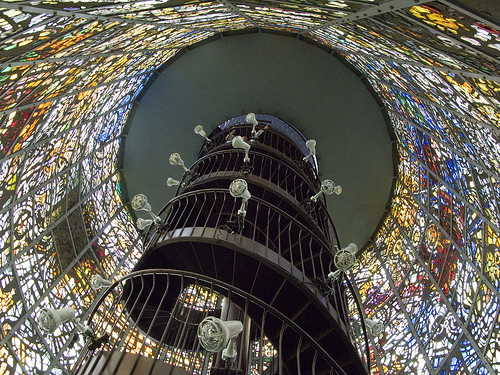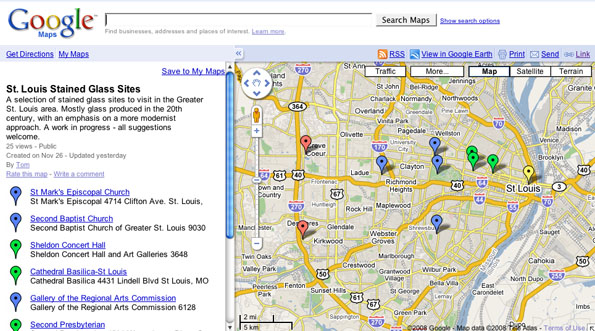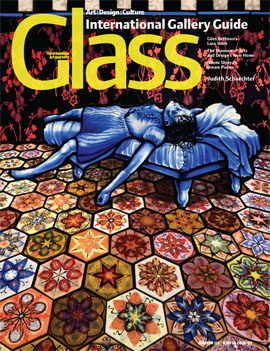December 30, 2008
How Buildings Learn
What with the holidays and my work schedule, it's been crazy busy lately, so no consistent posting. While I've been working, I've been watching/listening to various lectures and documentary series, mostly on google video, and mostly on favored topics like art and architecture. To me they are kind of like audio books, only with pictures. Nice for when I'm doing the really boring benchwork.
One of the series recently seen is How Buildings Learn, by Stewart Brand. Brand has posted the entire six-part, three-hour BBC TV series, which first aired in 1997, and is based on Brand's book of the same name.
The series as a whole is kind of slow going, but I like Brand's viewpoint. Simply put, that buildings are constantly changing things, and it's a good thing. The trick is how to go with the flow.
Stewart Brand is an unlikely architectural critic, seeing that he's best known as the creator of the Whole Earth Catalog, and is more recently best known for addressing issues regarding new media.
There is no specific mention of stained glass in the whole 6 parts, but there is one mention of glass in architecture in the first episode, where he refers to the poorly thought out use of glass in modern architecture.
Embedded here is that first episode, called 'Flow'.
If you want to only see the part about glass it's from 6:15 to 9:15.
December 24, 2008
Hallelujah
Okay, nothing to do with stained glass (and just skip the first 1:30), but 'tis the season, and I dare you not to smile.
Joyeux Noël
December 17, 2008
Finding the Symphonic Sculpture
or How to Let the Internet Do Your Marketing for You.
I'd never heard of the stained glass structure known at the 'Symphonic Sculpture', by Gabriel Loire, which resides at the Hakone Open air Museum, in Hakone, Japan.
How did I find out about it? Nothing to do with the Hakone Open Air Museum, that's for sure.
I was doing a general search for 'stained glass' on YouTube and came across this video. It's low resolution, and a bit shaky all around, but it was enough to get me intrigued.
My next stop was to go the official website, which is of little use. You have to scroll down to the very bottom of the collections webpage to see anything at all about the stained glass. Even then, it's just a name and a small image, with no backstory.
So, I went back to the web and, as usual, I tried a Flickr search for "Symphonic Sculpture", and there it was - interior shots, exterior shots both day and night, close-ups.
Wide angle interior shot by Aaron Paulson

Still no backstory yet, but I've seen enough to appreciate this as a pretty remarkable work of stained glass. Thanks to YouTube and Flickr.
December 13, 2008
Nancy Nicholson in the 2009 Smithsonian Craft Show
Nancy Nicholson has been accepted for the 2009 Smithsonian Craft Show - check out the Nancy Nicholson exhibitor page.
Big news, as it's pretty rare for a stained glass artist to make it into the show. I was in the 2000 Smithsonian Craft show and it was a great experience, and I'm still getting commissions from that show.
Though they have no information on past shows online, my sense is that the Smithsonian Craft show accepts a stained glass artist only once every 2-3 years, at best. It's said that there is always a ratio of something close to 100 to 1 of entries to acceptances. So on top it being great for Nancy, it's also great exposure for stained glass as well.
Kudos and best of luck to Nancy!!
December 11, 2008
Mapping Stained Glass Tours
I did a post last May about a website in the UK for a new Norwich Stained Glass Website. At the time I pointed out a unique feature which displays stained glass tours of Norwich called Trails. I checked it again recently, and it is improved and expanded. It's still incomplete and a bit confusing to navigate but what is up and working is very impressive.
The Norwich Trails idea works this way. You click on the 'trail' and it calls up a one page printable pdf with a map and images of several churches. For instance, The link for Trail 5 opens up a one page pdf of the four churches you could visit. Another area will go to webpages and bring up pdf's of the individual churches to get some idea of what they have for stained glass in that area, as well as logistical info. For instance, these are the links to the individual pdf pages for Trail 5 - St Peter in Ketteringham, St Mary Magdalen in Mulbarton, St Mary in Saxlingham Nethergate, and St Mary in Shelton.
This stoked my curiosity for something I'd been wanting to try for awhile. Google Maps lets you make custom maps. I wondered how it might work for mapping out stained glass tours.
I've been dabbling with it in my spare time for about 2 weeks and this is more a map of selected stained glass related sites in the St. Louis area, but worth a look. I may make some other maps that are more like a tour using the info from this map, with a suggested trail and timeline. I know from setting up tours myself, both formal and informal, that basic logistical information can be vital to the success of a tour.
St. Louis Stained Glass Sites on Google Maps

Consider this the 'beta' version. There will be changes.
All suggestions welcome.
December 04, 2008
Malcolm Miller at Chartres
Bits and pieces on Malcom Miller, the English Guide at Chartres Cathedral since the 1950's, and still going strong as of October, 2008 (and here). First, via a French Journal blog entry, a Globe & Mail article from last March called Decoding the windows at Chartres.
Now a short video of one of his classic bits, the audience participatory flying buttress demo. My guess is that this is from the early 80's -
Miller tends to illicit a love him or hate him response. Academics don't much like him, and some tourists don't like him because he can be brusque and arrogant. I find his manner prickly but I like some of his ideas, particularly the emphasis on the windows as narrative.
I know that some academics criticize him for emphasizing the 'Cathedral as library' idea that he touts so enthusiastically. I think the point scholars are trying to make is that there is no way to prove historically that the stained glass in Chartres or any other Cathedral was used as a teaching or storytelling tool.
Still, I've never quite understood why scholars tend to downplay the narrative aspects of the windows. It's so obvious, and so unique. I've covered this sequential narrative aspect of Gothic stained glass in blog posts before - in The Comics Thing and Hypertexting the Gothic Cathedral. I would highly recommend Stuart Whatling's Corpus Narratologica site if you're interested in narrative in medieval stained glass.
Malcolm Miller goes into this narrative aspect in a 2001 NPR radio interview, from the program 'All Things Considered' - Chartres Cathedral on NPR. One narrative window he discusses, the Good Samaritan window, is the window I heard him 'read' when I saw him at Chartres in 1985.
December 03, 2008
Judith Schaechter In Glass Quarterly
Interview with Judith Schaechter in the Winter 2008-09 / Issue 113 of Glass Quarterly. I haven't seen it yet, but the issue seems focused on the new Museum of Art & Design building, including Judith's commission.
She snagged the cover too.

December 02, 2008
Connick - Article and New Book
Article in the Pittsburgh Tribune-Review on Charles Connick in Pittsburgh, coinciding with the publication of a new book on Connick called Charles J. Connick: His Education and His Windows in and near Pittsburgh by Albert Tannler, Historical Collection Director for Pittsburgh History & Landmarks Foundation.
Not related to Connick in Pittsburgh, but of interest to the Connick Studio enthusiast nonetheless, this is a preview of the documentary film, The Last Window, a documentary made just before the Connick studio closed shop in 1986.
I was living in Boston when the Connick Studio closed and the studio I was working for at the time helped in dealing with all the accumulated stuff. The Connick studio, at its close, occupied four floors of a building and there was decades worth of material to deal with. I'm still working off of some of the sheets and scraps of glass I obtained from their rows and rows of glass racks, and I only got a tiny fraction of what they had. I can remember whole crates of glass, opened but unused, dating from the 40's and 50's, just lying around.
The Connick legacy is represented by the Connick Foundation. It's a legacy worth preserving.